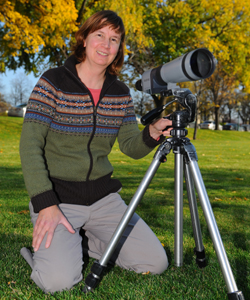Susan Lingle - Animal Cooperation

Altruism on the Prairies
Dr. Lingle’s research focuses on the evolution of prey defenses as it affects their biology, psychology, and ecology. A focal point in her research is animal cooperation witnessed predominantly in defense against a predatory threat.
Dr. Lingle’s comparative study of two closely related species (the white-tailed deer and the mule deer) reveals astonishing differences in co-operation when reacting to the cry of a threatened fawn. Prior to taking any defensive action, the whitetail will first verify if the young is her own. The mule deer will immediately bolt to the defense of the fawn regardless if the fawn is even of her own species. The mule deer’s seemingly altruistic behaviour is difficult to understand because the mule deer derives no apparent benefit from defending a whitetail fawn. To understand the evolution of this behaviour, Dr. Lingle expanded her study to genetically intermediate subspecies and other species to discover if altruistic defense must be present to ensure defense of one’s own fawn. The findings indicate this is not the case. Altruism remains a long standing puzzle in evolutionary biology.
Prey defensive behaviour also affects vulnerability. Particular species are more vulnerable during certain seasons which in turn influences the predators’ choice of prey. Mule deer are more vulnerable in winter, whitetails in the summer. However, the abundant presence of a third prey, say, ground squirrels, will alleviate the predatory danger to whitetails in the summer and be transferred to mule deer with the arrival of winter once the ground squirrels head underground.
The study of ecology normally builds upon the relation of prey numbers to predator numbers. However, scarcity and abundance reveal only part of the answer. A more complete view of the ecological systems is required. For example, preferring to fight, mule deer choose a rugged slope. Whitetails favour flight over gentle ground. Dr. Lingle proposes it is prey behaviour that drives predator decisions. Simply put, “It’s the prey that calls the shots.”
Most of Dr. Lingle’s work has been conducted on the prairie grasslands of western Canada. The prairies possess one of the largest proportions of at-risk plants and animals of any ecosystem in North America. Dr. Lingle uses an understanding of prey behaviour, seasonal vulnerability, and unintentional provisioning of predators through human activities to identify the reasons that prey on the prairie are at particular risk. She collaborates with others to increase awareness of the plight of the prairie and to address the problems that currently face many prey species living on the prairie.
Photo By DanHarperPhoto.Com
